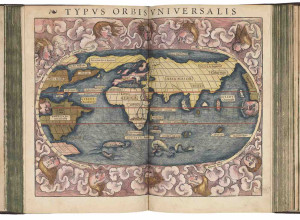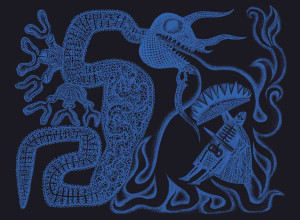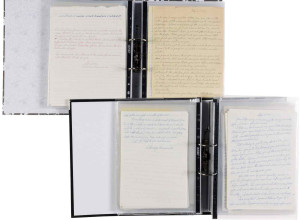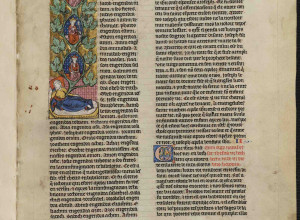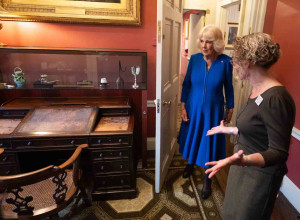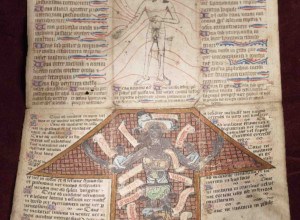Charles Magnus, Lithographer: An Interview with E Richard McKinstry
We recently interviewed E. Richard McKinstry, Library Director at Winterthur Museum, about Charles Magnus, the 19th century lithographer, and the subject of McKinstry's new biography out now with Oak Knoll Press.
Let's start with a basic intro: Who was Charles Magnus?
Charles Magnus was a printer and storekeeper who was active in New York City for the last 50 or so years of the 1800s. He was born in Elberfeld, Germany in 1826 and came to the United States in 1848 possibly as a result of the political upheavals in Europe at the time. Magnus was always regard as a mapmaker, first because of a momentous project, his Commercial Atlas of the World, and then because he published so many other maps. But, he also issued what we today call paper ephemera: songsheets, illustrated letterheads, greeting cards (especially comic valentines), puzzles, games, decorated envelopes, bird's eye views of cities, prints, and so on. And, he published a few books. Magnus supported the Union during the American Civil War through his imprints. He may not have created different products during the war, but he certainly adapted what he printed to promote the North. Envelopes became patriotic in nature and lettersheets and songsheets featured battle scenes and wartime songs. Gradually, Magnus turned his energies to storekeeping. At least I think so because his recorded imprints became fewer and fewer as the century progressed.
Was Magnus a trained lithographer when he emigrated? Or did he take up lithography after his arrival in the United States?
He took up the business after he arrived in the United States. Elsa Amberg, one of his granddaughters, wrote that she thought her grandfather worked as a salesman for a silk firm in Elberfeld before he left for America, Elberfeld being a center of the German silk industry. Elsa also said family lore suggested he may also have been employed making playing cards. I don't think Magnus ever worked on a lithographer's stone himself. He was more of an agent, promoter, and storekeeper, employing workers to create the products he sold.
Did Magnus maintain a connection with Germany?
With Germany, Europe, and with a German speaking public in the United States. Magnus credits European illustrators on some of his works, for example. In addition, he sold a child's A-B-C book, Comic Picture Book, whose words were in French and which may have originally been a European publication. Magnus likely added his imprint to the front cover. Evidence suggests that Magnus's commercial atlas was published cooperatively with George Philip and Son, an English firm. Magnus advertised in America in German language newspapers, issued prints with captions in German, and advertised his products on his own prints using the German language. Magnus published likenesses of German-Americans (engineer John Roebling and Civil War soldier Major-General Franz Sigel, for example). Finally, one of his products was geared to a German audience, a German Head Line Copy Book "in eight numbers, known to be the best series, introduced and adopted in most of the German High Schools."
How large was his business in its heyday?
How I wish I knew. Magnus's account books and other business records have not survived, and I haven't even seen a Magnus invoice. Because Magnus published thousands of items during the Civil War, his business was undoubtedly larger in the early 1860s than at any other time. In 1889, twenty-five years after the war, R.G. Dun, the credit rating firm, noted that Magnus ran a small business--whatever that meant--without yielding much of a profit and that he claimed it was worth $50,000, a figure Dun judged high. At the end of his career, in 1900, in an official report New York State's factory inspector stated that Magnus employed on the average ten males and one female who contributed sixty hours of labor, presumably each week they worked.
Does Magnus have any distinguishing characteristics in his work? Can you tell a Magnus piece of ephemera from another piece of late 19th century ephemera?
Not reluctant to credit himself, Magnus usually signed his work, which is the obvious giveaway. He also reused the same illustration on different products, so if someone sees an image once, he or she shouldn't be surprised to run across it again, perhaps many times. After viewing so many Magnus products, it is fairly easy for me to identify them even if his credit line doesn't appear. Songsheet and lettersheet layouts vary little, for instance, and their images follow patterns. Some of Magnus's products are quite good, but many are run of the mill I suspect because he printed large quantities of copies rapidly for quick sale.
What are some of your favorite pieces of ephemera printed by Magnus?
In a sense, I still look forward to seeing my favorite. Even though my book has now been published I continue to be on the watch for his work. For imagery, my favorites are cityscapes. Although I was raised in a rural village in northern New Jersey and now live in a small town in southeastern Pennsylvania, I have always been drawn to urban scenes. I especially like pre-20th century architecture. Considering Magnus's work where text takes over, my favorites are his songsheets. Historians studying the history of American music would do well to consult them.
How is Magnus viewed by scholars and collectors today? What is his legacy?
Two thoughts about researchers: Through prints especially, Charles Magnus together with his contemporaries have provided resources that illustrate urban, suburban, and rural imagery that would have been lost to time if they had not been in business. And because Magnus's products appealed to large audience, anyone interested in art for the masses should be drawn to Magnus. For collectors: In the marketplace, Magnus items are still relatively inexpensive, so anyone interested in building a collection of his works can do so with modest investment. On eBay, for example, some of his pieces sell for less than twenty dollars. Of course, with the publication of my book, his appeal--and prices for his imprints--might increase.
McKinstry's book is available to purchase from Oak Knoll Press.






